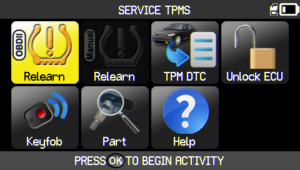Retour à toutes les actualités
28.05.2020
EMEA TPMS diagnostic tips on RENAULT MEGANE 4 (2016-2020)
The European regulation no. 661/2009 of 13 July 2009 and its official application on November 1, 2014 obliges all vehicles manufactured in Europe to be equiped with a direct or indirect TPMS systems warning the driver, inside the vehicle, of any loss of tyre pressure, which is conducive to optimum fuel consumption and road safety” (chap. II, art. 9).
RENAULT MEGANE 4

The Renault Megane 4 (2016-2020) uses a direct TPMS system, which means TPMS sensors are installed in the wheel. If one or more tires indicate low tire pressure, the TPMS sensors will transfer the information to the vehicle’s ECU. An indicator light (low-line TPMS system) or each tire pressure will show on the dash (high-line TPMS system).
When a sensor is replaced for one or more wheels of a Renault Megane 4, a TPMS relearn is recommended to transfer the new TPMS sensor IDs to the vehicle’s ECU.
Type of TPMS System – Direct TPMS System
TPMS Sensors are installed in the wheel, tire pressure is communicated via radio frequency (RF) technology from the sensor to the vehicle’s ECU.
Type of TPMS frequency
433 MHz
OE and Aftermarket (Universal, Hybrid, Programmable, Configurable, One-to-One, OE-style) options for TPMS sensor replacement
All OE and Aftermarket programmable, configurable, hybrid and OE-type (one-to-one) TPMS sensor options and service kits can be found in the VT56 TPMS Tools and most Powered by ATEQ tools.
Type of TPMS tool required for TPMS light OFF
TPMS activation tool such as VT15, VT36, VT46 or VT56 for manual relearn.
VT56 and VT46 TPMS SCAN TOOL with OBDII module includes Sync ID technology for software versions DA1-32-12 and higher for bonus OBD relearn.
RENAULT MEGANE 4 OBD RELEARN PROCEDURE

1/7 – Set tyre pressure
2/7 – Read all sensor ID’s
3/7 – Turn Ignition ON (engine on) by using Hands-free key card (with key-less entry system)
4/7 – Connect the OBDII Cable/Module to OBD connector
5/7 – Follow the screen’s instructions to reset the ECU
6/7 – Turn ignition to OFF then ON (engine off)
7/7 – Wait for 20 min
NOTICE: If the TPMS warning lamp remains ON, then drive for 20 min
LEARN HOW TO PROCEED AN OBD RELEARN ON A RENAULT MEGANE 4

TROUBLESHOOTING TIPS
TPMS light stays “solid” after driving and successful transfer
1. Pressure incorrect – Ensure tire pressure matches vehicle spec with
inflator. Compare reading bytriggering sensors.
2. Temperature incorrect – Trigger sensors to verify temperature.
TPMS light “flashing” after driving and successful transfer
1. Sensor BAT LOW – Trigger sensor and check battery status.
2. Bad accelerometer – Replace sensor.
3. Defective sensor – Some non-OE sensors will cause the TPMS light to flash even after successful transfer. Replace with OE compatible sensor.
Letters “TPMS” on the dashboard are lit
1. DTC stored in memory – Read and clear.
Sensor not detected
1. Tool position snap & clamp in sensors
Position tool antenna parallel to the ground, above the valve stem, touching the tire side wall.
2. Tool position banded sensors
If properly installed, sensor should be 180° from the valve stem. Place tool on the sidewall at this location. If not, check every 90°.
3. Wrong sensor for the vehicle
Check sensor part number, compare withpart number in the tool or call support.
4. Defective sensor
Replace sensor.
5. Indirect TPMS system
Indirect TPMS doesn’t use sensors (check relearn procedure).
OBDII connection failure
1. OBDII module not required
Check relearn procedure, vehicle may not require an OBDII relearn.
2. Ignition is not in on position
Make sure ignition is in ON position, engine off.
3. Sensor not triggered
Ensure all 4 or 5 sensors are triggered.
4. OBDII transfer failure
Tool must recognize the OBDII module. LED on module should be flashing green.
5. Vehicle battery low
Check the voltage of the battery.
6. OBDI connection failure
Poor connection between OBDII module and OBDII connector. Damaged pins on OBDII module. Damaged OBDII connector.
Contact us ATEQ TPMS Tools Europe
Follow us on SOCIAL MEDIA #ATEQ TPMS Tools Europe
Un nouveau décret du ministère des transports vise...
Relearn procedures differ from manufacturer to manuf...
TPMS relearn procedure and other TPMS diagnostic sys...